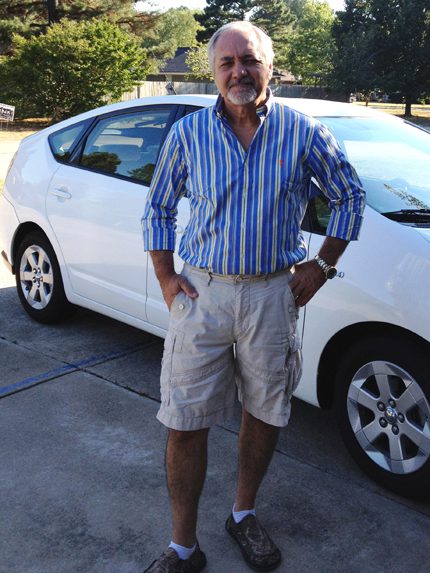
22 Sep 2012 Overweight no more: Weight loss 'stars' tell all
by John Patton
No shakes, no pills or powders are required.
Grapefruit-only diets are off limits.
Please, no head stands while eating.
“It’s all the rage, and it’s the newest fad diet ever; you count calories and you exercise,” quips DeAnna Smith, who has lost a whopping 146 pounds in two years.
Consistency and accountability are needed.
Counting carbohydrates and calories, keeping a food journal, drinking lots of water and exercising at least four days a week over time can produce some amazing weight loss results. Don’t believe it?
Two long-standing health programs at Conway Regional have the weight loss “stars” to prove it. Word-of-mouth has spread the news about the successful “real world” weight loss support group program that Kellie Dye, a certified, registered dietitian, coordinates at the Conway Regional Health & Fitness Center. Dye has been teaching people how to lose weight for more than 20 years.
Another program that has achieved impressive results is Conway Regional’s Diabetes Self Management program. A diagnosis of diabetes is required to get into the program, and weight loss is a secondary goal for participants who must first manage their diabetes. However, diabetes program coordinator Rhonda Monfee has some weight loss “stars” as well, including Don Harris who drives an hour from Dover (Pope County) once a month to participate in the program. Monfee is a registered dietitian and a certified diabetes educator.
“Eating healthy in the real world” is Dye’s mantra as she teaches participants in her weight management classes how to record food journals, count calories, read food labels and measure healthy portions of food. Dye and her students swap recipes and tips at 5:15 p.m. Wednesdays and at 12:15 p.m. Thursdays at the fitness center.
Monfee’s program is physician referral based. She gets patients who are diagnosed with diabetes or pre-diabetes and teaches them how to count carbohydrates, test their blood sugar level and eat healthier, less processed foods. They are also shown how to read food labels.
Both programs stress eating small meals and healthy snacks, drinking lots of water, exercising at least four to five days a week, avoiding high calorie fast food, and yes, patience and accountability. Losing one to two pounds of weight a week is the best way to keep it off, Dye says.
“Ninety percent of success is keeping track of what you are eating; it helps you be accountable,” adds Monfee. “We try to promote a wellness-based change in lifestyle.”
Kim Scott of Conway, a teacher at Carolyn Lewis Elementary School, knows the value of patience when it comes to weight loss. “It has taken me almost two years to lose almost 100 pounds,” said Scott.
It has been worth the wait. “I notice a big difference in how I feel. I don’t ache anymore; my knees don’t hurt in the morning. I’m not sore,” she said.
Kim turned to Kellie Dye’s Weight Management program after talking to her friend DeAnna Smith.
“I learned so much. I had no idea what a portion was, and that was a big eye opener for me,” said Scott. “I kept a food journal for about a year. Now, I look up what I eat on an app called MyFitnessPal.com.” This free program allows users to track calories, carbohydrates, protein, fat, sodium and other weight-loss factors.
After a few months Scott added exercise to her daily routine. “Start slowly,” she said. “I started slowly walking on the treadmill and worked up from there.” Now she exercises twice a day.

DeAnna Smith of Conway, a human resources technician with Conway Corporation, gives Kellie Dye the credit for changing her “stinking thinking,” i.e., using food for comfort or to relieve stress. “I can hear her in my head, asking ‘is that really the best choice?’”
DeAnna realized she needed weight loss help after returning to Conway after traveling with her husband during his Air Force career and “got a ‘wow, what happened to you?’”
She was determined to make a change and kept hearing about the Weight Management group.
Dye taught her how to count calories. “I began to realize how much I was eating.” As her weight loss progressed, Smith began to exercise.
“Along with counting my calories, I was walking. I just slowly built up. I walk five miles a day now,” she said.
After 146 pounds,
her weight loss is “more than half of myself.”
In addition to Dye, she credits a “wonderfully supportive family” and friends in the support group. “I am thankful for taking the classes and meeting people who spur each other on; it brings accountability.”
Her advice: “Your weight loss journey is something you have to decide you want. It is not something that someone else can do for you. It is very doable.
“We live in an age of instant gratification, but the weight did not come on over night. I have learned that after it comes off (slowly), it stays off. The time is irrelevant compared to the amount of energy I have, how much stronger I am and how much better my outlook on life is.”

Jim Baker of Conway is a believer as well.
“It really made a difference for me; it was life-changing,” said Baker, who works at Interstate Group, LLC. About a year ago Jim’s 5-foot-9 frame carried 220 pounds, his A1C blood glucose level was 13.5 and his doctor, David Naylor, was concerned.
Jim wasn’t feeling well and learned his blood sugar was elevated. He was diagnosed with adult onset diabetes. “I was feeling tired, run down.”
After trying to change his lifestyle on his own did not work, Dr. Naylor referred him to the Conway Regional Diabetes Self Management program.
Jim’s wife, Vicki, joined him for the first diabetes management class.
“They taught us how to eat properly and count carbs,” he said. “Over 75 days, we lost about 40 pounds each.”
Jim cut sweets out of his diet and learned to count carbohydrates.
Now his A1C is 5.9, and he has lost 42 pounds. Vicki lost 55 pounds. He went from 38 to 33 inches in his waist.
He no longer has to check his blood sugar, and the specter of taking medicine to manage diabetes no longer hangs over his head.
“I feel so much better.”

Don Harris of Dover, a locksmith, learned the importance of eating right and exercise through the Conway Regional Diabetes Self Management program.
In December 2010, Harris learned he was having issues with uncontrolled diabetes. After seeing a blood sugar level of 600, his family doctor decided he should be hospitalized.
“We went to Conway Regional because we had heard good things about it,” said his wife, Bonnie.
Don remained in the hospital for several days and was sent for consulting to Rhonda Monfee. After taking diabetes education classes, Don and Bonnie began to control their diet. “His goal is to eat right and manage his diabetes,” said Bonnie.
Don left the hospital with an A1C rating of 9.9. A year and a half later, he is no longer taking medication for diabetes and has lost 40 pounds.
“I decided I didn’t want to take that medicine the rest of my life, so I did something about it,” Don said. “I try to watch what I eat, watch the portions and try to exercise daily.”
Bonnie points to a change in their eating habits and 30 minutes of exercise on an elliptical exercise machine each day. Even after a recent heart procedure, “I’m back up to 30 minutes a day,” said Don. “I feel like a new man.”
His advice to those who want to lose weight and control diabetes: “Watch the carbs, watch the sugar intake and cut the portions in half and try to exercise. You shouldn’t skip any meals.”








